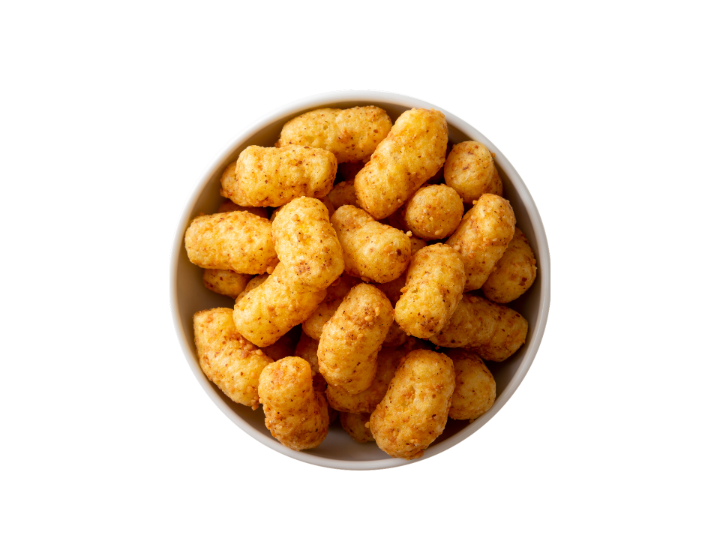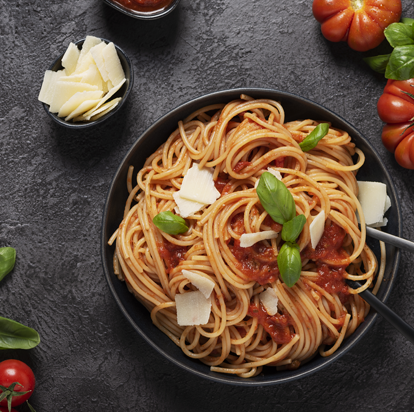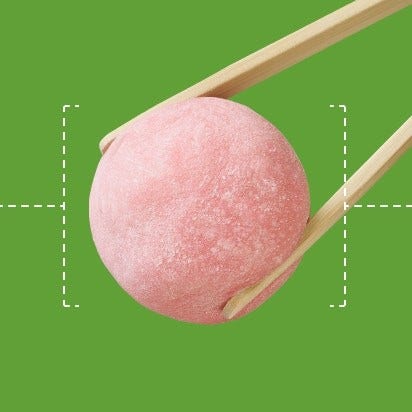
At a glance
Food coatings are revolutionizing texture and shelf-life performance across categories like bakery, snacks, frozen meals and plant-based foods.
Key insights:
- Food coatings in manufacturing: Coatings enhance texture, flavor, shelf life and appearance — critical for ready meals, QSR foods and plant-based snacks
- Functional benefits: Coatings serve as barriers, texture enhancers, flavor carriers and nutrient delivery systems, improving moisture control, oxidation resistance and consumer appeal
- Ingredient innovation: Ingredion’s portfolio includes native and modified starches, hydrocolloids, plant-based polymers and proteins — supporting clean label and allergen-friendly formulations
- Consumer impact: 25% of consumers say texture matters more than flavor; 52% won’t eat food if the texture is off — making texture optimization essential for repeat purchases
- Application systems: Coating methods include immersion, spray, drum and pan coating, each tailored to product type and scalability needs
As economic growth and urbanization lead to busier lifestyles, there is rising demand for convenient solutions like ready meals and deliveries. This trend — along with the consumer desire for indulgent clean label foods and a preference for multitexture and multiflavored experiences — is driving brands to innovate. They are tasked with developing products that retain those desired textures, even after extended hold and delivery times, reheating, air-frying and other prep methods.
Food coatings play a vital role in meeting all of these demands throughout the manufacturing process.
What are food coatings?
Food coatings are applied to the exterior of food products to improve the quality or enhance functionality in a number of ways. There are a few primary functions that may apply:
- Barrier: Food processing coatings can be used to create a stable environment within the packaging to retain the right moisture level, limit oxidation and protect against potentially harmful bacteria growth
- Texture enhancer: Coatings can be used to achieve consumer-preferred textures, like adding a crunchy quality to fried or baked goods or reducing sogginess by keeping moisture out
- Flavor carrier: Manufacturers can achieve either sweet or savory flavors with food coatings, such as batters and breadings infused with herbs or chocolate and sugar used to coat desserts
- Nutrient carrier: Food coatings can also deliver better nutrition labels in the form of whole grains, fiber enhancement or natural, plant-based products
Some food coatings can be used as a film to extend shelf life while cutting back on synthetic packaging. Think wax coverings on cheese or collagen casings on sausage. Coatings can also be functional. Anticaking coatings prevent clumping in shredded cheese, while sauces and glazes can be added to frozen meals and vegetables for enhanced flavor. Additionally, surface treatments on snacks, baked goods and other items can prevent sticking and improve their appearance.

Meaningful innovation is underway in the field of food coatings
Health-conscious consumers seek products that deliver enhanced nutritional and functional benefits without compromising on taste or texture. The growing demand for clean label and plant-based ingredients is also prompting brands to diversify their coating offerings.
The sensory signature of coated foods
The overall texture of a product has a significant impact on consumer satisfaction and future purchase decisions. In fact, 25% of consumers say that texture is more important than flavor, and 52% say they wouldn’t eat a food if the texture wasn’t right.1 Beyond their many functional roles, food coatings also play a critical part in delivering desirable texture.
Perfecting the coating on food products is essential to achieving the desired texture
This is particularly true in products where crispiness and crunch are key. The sound, bite and mouthfeel of a product all contribute to the overall sensory experience, influencing how consumers perceive quality. In fact, these multisensory cues can enhance the perception of taste and freshness, elevating the eating experience.

Ingredion uses a food structure and ingredient function approach to help brands design the ideal texture in every food category. Whether you’re looking for a crispy, chewy, creamy or other distinctive texture, the right coating can elevate your product’s sensory appeal and encourage repeat purchase.

Ingredients that power coating performance
Different ingredient types within the food coating market deliver different functional benefits.
- Native starches: These clean label ingredients are naturally derived and may be available in non-GMO versions, and they pack a punch when it comes to providing texture and stability in a range of formulations
- Modified starches: Altered to maximize functionality in both freezer and shelf-stable foods, modified starch textures can add consistency and sheen while also managing oil uptake and texture
- Plant-based polymers: Ideal for agricultural formulations, Ingredion’s plant-based polymers avoid petroleum and synthetic chemicals and are both sustainable and renewable
- Hydrocolloids: Ingredion’s hydrocolloid coatings offer both conventional and naturally derived options from sources like seeds and seaweed, and they’re designed to improve mouthfeel, emulsification and viscosity
- Proteins: There are several protein varieties used as coatings to enhance shredded cheese, confectionary and much more
In addition to supporting clean label formulations, many food coating ingredients are also allergen-friendly. Whatever your product claims or positioning goals may be, there are solutions available that align with both functional requirements and consumer expectations.
Applications and use cases
Edible food coatings are used in many ways, including shelf-life extension in food and more. Additionally, their versatility allows them to perform effectively across multiple application areas.
- QSR and frozen foods: Coatings contribute to a fresh, crisp flavor and texture in products like fries, breaded chicken and seafood and plant-based snacks, whether they need extended shelf life under a heat lamp or a consistent texture when thawing
- Bakery and confectionary: Appearance plays a crucial role in encouraging consumers to choose their next baked good, and the right coating can enhance surface shine while also keeping moisture in check
- Ready-to-eat meals: Freeze/thaw performance is key for ready-to-eat meals, and without the right coating, the food can quickly get soggy and lose its texture
Practical considerations for formulators
Coatings aren’t just about ingredients. They’re also about the coating system process for applying them to your products. There are four primary types of application systems:
- Immersion: Also called dip coating, the product is immersed in a liquid formulation with the ability to adhere to the surface before given time to cure (often with heat or UV light) 2
- Spray: Spray nozzles are used to apply liquid coating, which coalesces to the product 3
- Drum: In this process, the product moves from a conveyor belt into a drum, which tumbles and coats the product before turning it out onto a sifting conveyor 4
- Pan coating: Ideal for small items like nuts and pills, pan coating machines are tilted and rotated as the coating is distributed throughout the product 5
It’s also important to think about formulation challenges in advance. Texture retention is crucial for just about every type of application. On top of that, consider scalability depending on the volume expected to be produced at one time.
Ingredion’s expertise in food coatings
Ingredion is a leading innovator in texture coatings, offering a diverse portfolio of specialized ingredients designed to meet evolving nutritional and sustainability trends. We also advance shelf-life solutions across a wide range of applications, continually pushing boundaries of performance and functionality.
Our team of experts understands the challenges manufacturers face today, balancing consumer demands for flavor and texture with clean label expectations and product stability, whether on the shelf, in the freezer or in a quick-service restaurant.
Achieve a multisensory experience consumers crave
Ingredion can help your team customize texture and film-forming characteristics. We also focus on the metrics that matter most, like extending hold time, improving solids suspension and increasing coating adhesion to keep waste and costs at a minimum.
Our food coating products include starches, hydrocolloids, proteins and more. Whether you’re reformulating an existing product or launching a new one, Ingredion can create customized solutions that fit your products’ unique needs.

Meet the expert
Related content and resources
Explore how Ingredion can bring your vision to life with industry-changing ingredient solutions

The science behind texture that sells
Consumers prefer crispy and crunchy foods, but achieving these textures can be challenging. Discover our solutions to common formulation issues.

Clean label ingredients
Our comprehensive portfolio of clean label ingredient solutions covers a wide variety of functional needs so you can deliver eating experiences that keep consumers coming back for more.

The Texture EquationSM
Backed by over 100 years of texture expertise, we know what it takes to develop market-winning products that shape perceptions and set brands apart.
Sources:
- Ingredion Texture Research study, 2024
- https://opgbiosolutions.com/the-science-behind-immersion-coating-enhancing-food-packaging-durability/
- https://www.lechlerusa.com/en/blog/consistent-spray-coatings
- https://www.ipharmachine.com/complete-guide-to-coating-pan srsltid=AfmBOopcfKG2VuZLrIYp3j8EchCg-LkhMib-iit9VcvruO04GAVz3ApX
- https://www.ipharmachine.com/complete-guide-to-coating-pan?srsltid=AfmBOopcfKG2VuZLrIYp3j8EchCg-LkhMib-iit9VcvruO04GAVz3ApX
*Product availability and costs may vary across global regions. Contact an Ingredion representative to learn more.